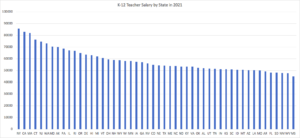Are higher K-12 teacher wages enough?
According to the MassEconomix database at Pioneer Institute, elementary and secondary schools have seen the highest wage growth, i.e., 65.4 percent, compared to other education sub-sectors from 2002-2019 in the state of Massachusetts. In 2020, the average K-12 teacher salary, adjusted to the cost of living, was $81,535 in Massachusetts, compared to a U.S. median of $64,524. It jumped to $82,042 in 2021, making Massachusetts the third-highest teacher-paying state in the country.

The graph above depicts the K-12 teacher salary across the United States for 2021. (Source: World Population Review)
Both K-12 teacher wages and state education standards started rising with the Massachusetts Education Reform Act of 1993 (MERA). MERA allowed Massachusetts to lead public education reform by doubling the funding of K-12 education from $1.3 billion in 1993 to $2.6 billion in 2000. Additionally, state frameworks were developed with English, mathematics, science, and history standards, and students were obligated to start studying algebra in eighth grade. These policies raised education standards along with teacher pay. As a result, beginning in 1993, Massachusetts SAT scores rose for 13 consecutive years, and early childhood education increased by 247 percent between 1996 and 1999. Similarly, the K-12 teacher pay went up by an average of 34 percent between 1990-2000.
While wage growth and improved educational standards are commendable, in 2016, the average salary for full-time teachers varied by $50,000 across school districts in Massachusetts. The wealthier communities, such as Weston and Wellesley, paid their teachers an average salary of more than $90,000 during the 2014-15 academic year, whereas economically diverse places such as Franklin paid its teachers approximately $73,230. This salary variation is a disadvantage to municipalities with fewer resources, because they operate at a risk of losing their teachers to well-resourced school districts.
Similarly, gaps in opportunities and achievements have been persistent for students of color and those belonging to low-income families. For instance, 1 in 3 English learners do not graduate on time, and 1 in 7 drop out of school. As for the students of color, only 1 in 3 Black and Hispanic SAT takers fulfill mathematics and English standards for college readiness, compared to 2 out of 3 of their white peers.
This was not always the case. Between 1998 and 2005, Massachusetts was one of the only three states to narrow the racial achievement gap. Additionally, between 2005 and 2009, the NAEP scores of African American and Hispanic students were higher than those of their white counterparts.
In a 2020 Commonwealth Magazine op-ed, Pioneer senior fellow Tom Birmingham and renowned educator and literary critic E.D. Hirsch state that there is a correlation between academic quality and equity. According to them, the 2010 shift from rigorous to weaker English and Mathematics standards, known as Common Core, allowed the gaps to creep in. The duo suggests that the state must reform its schools and district-level curriculum to impart knowledge to students in every school district equally.
MERA allowed the state of Massachusetts to emerge as a national leader in education. Rigorous and internationally benchmarked academic standards provided students from disadvantaged backgrounds an opportunity to shine and increased teacher’s wages.
While teacher wages have shown a positive trajectory in recent years, Massachusetts turned its back on the standards that allowed it to emerge as a champion. Tom Birmingham and E.D. Hirsch suggest that the state must commit itself to a high-quality curriculum to get back in the groove.
Maida Raza is a rising Senior at Earlham College. She is pursuing a Bachelors’s in Economics and Mathematics. Maida is working as a MassEconomix Intern at Pioneer Institute.



